Intel Core i7-11700K Review: Blasting Off with Rocket Lake
by Dr. Ian Cutress on March 5, 2021 4:30 PM EST- Posted in
- CPUs
- Intel
- 14nm
- Xe-LP
- Rocket Lake
- Cypress Cove
- i7-11700K
Power Consumption: Hot Hot HOT
I won’t rehash the full ongoing issue with how companies report power vs TDP in this review – we’ve covered it a number of times before. But in a quick sentence, Intel uses one published value for sustained performance, and an unpublished ‘recommended’ value for turbo performance, the latter of which is routinely ignored by motherboard manufacturers. Most high-end consumer motherboards ignore the sustained value, often 125 W, and allow the CPU to consume as much as it needs with the real limits being the full power consumption at full turbo, the thermals, or the power delivery limitations.
One of the dimensions of this we don’t often talk about is that the power consumption of a processor is always dependent on the actual instructions running through the core. A core can be ‘100%’ active while sitting around waiting for data from memory or doing simple addition, however a core has multiple ways to run instructions in parallel, with the most complex instructions consuming the most power. This was noticeable in the desktop consumer space when Intel introduced vector extensions, AVX, to its processor design. The concurrent introduction of AVX2, and AVX-512, means that running these instructions draws the most power.
AVX-512 comes with its own discussion, because even going into an ‘AVX-512’ mode causes additional issues. Intel’s introduction of AVX-512 on its server processors showcased that in order to remain stable, the core had to reduce the frequency and increase the voltage while also pausing the core to enter the special AVX-512 power mode. This made the advantage of AVX-512 suitable only for strong high-performance server code. But now Intel has enabled AVX-512 across its product line, from notebook to enterprise, allowing these chips to run AI code faster and enabling a new use cases. We’re also a couple of generations on from then, and AVX-512 doesn’t get quite the same hit as it did, but it still requires a lot of power.
For our power benchmarks, we’ve taken several tests that represent a real-world compute workload, a strong AVX2 workload, and a strong AVX-512 workload. Note that Intel lists the Core i7-11700K as a 125 W processor.
Motherboard 1: Microcode 0x2C
Our first test using Agisoft Photoscan 1.3 shows a peak power consumption around 180 W, although depending on the part of the test, we have sustained periods at 155 W and 130 W. Peak temperatures flutter with 70ºC, but it spends most of the time at around the 60ºC mark.
For the AVX2 workload, we enable POV-Ray. This is the workload on which we saw the previous generation 10-core processors exceed 260 W.
At idle, the CPU is consuming under 20 W while touching 30ºC. When the workload kicks in after 200 seconds or so, the power consumption rises very quickly to the 200-225 W band. This motherboard implements the ‘infinite turbo’ strategy, and so we get a sustained 200-225 W for over 10 minutes. Through this time, our CPU peaks at 81ºC, which is fairly reasonable for some of the best air cooling on the market. During this test, a sustained 4.6 GHz was on all cores.
Our AVX-512 workload is 3DPM. This is a custom in-house test, accelerated to AVX2 and AVX512 by an ex-Intel HPC guru several years ago (for disclosure, AMD has a copy of the code, but hasn’t suggested any changes).
This tests for 10-15 seconds and then idles for 10 seconds, and does rapidly go through any system that doesn’t run an infinite turbo. What we see here in this power only graph is the alarming peaks of 290-292 W. Looking at our data, the all-core turbo under AVX-512 is 4.6 GHz, sometimes dipping to 4.5 GHz. Ouch. But that’s not all.
Our temperature graph looks quite drastic. Within a second of running AVX-512 code, we are in the high 90ºC, or in some cases, 100ºC. Our temperatures peak at 104ºC, and here’s where we get into a discussion about thermal hotspots.
There are a number of ways to report CPU temperature. We can either take the instantaneous value of a singular spot of the silicon while it’s currently going through a high-current density event, like compute, or we can consider the CPU as a whole with all of its thermal sensors. While the overall CPU might accept operating temperatures of 105ºC, individual elements of the core might actually reach 125ºC instantaneously. So what is the correct value, and what is safe?
The cooler we’re using on this test is arguably the best air cooling on the market – a 1.8 kilogram full copper ThermalRight Ultra Extreme, paired with a 170 CFM high static pressure fan from Silverstone. This cooler has been used for Intel’s 10-core and 18-core high-end desktop variants over the years, even the ones with AVX-512, and not skipped a beat. Because we’re seeing 104ºC here, are we failing in some way?
Another issue we’re coming across with new processor technology is the ability to effectively cool a processor. I’m not talking about cooling the processor as a whole, but more for those hot spots of intense current density. We are going to get to a point where can’t remove the thermal energy fast enough, or with this design, we might be there already.
Smaller Packaging
I will point out an interesting fact down this line of thinking though, which might go un-noticed by the rest of the press – Intel has reduced the total vertical height of the new Rocket Lake processors.
The z-height, or total vertical height, of the previous Comet Lake generation was 4.48-4.54 mm. This number was taken from a range of 7 CPUs I had to hand. However, this Rocket Lake processor is over 0.1 mm thinner, at 4.36 mm. The smaller height of the package plus heatspreader could be a small indicator to the required thermal performance, especially if the airgap (filled with solder) between the die and the heatspreader is smaller. If it aids cooling and doesn’t disturb how coolers fit, then great, however at some point in the future we might have to consider different, better, or more efficient ways to remove these thermal hotspots.
Motherboard 2: Microcode 0x34
As an addendum to this review a week after our original numbers, we obtained a second motherboard that offered a newer microcode version from Intel.
On this motherboard, the AVX-512 response was different enough to warrant mentioning. Rather than enable a 4.6 GHz all-core turbo for AVX-512, it initially ramped up that high, peaking at 276 W, before reducing down to 4.4 GHz all-core, down to 225 W. This is quite a substantial change in behaviour:
This means that at 4.4 GHz, we are running 200 MHz slower (which gives a 3% performance decrease), but we are saving 60-70 W. This is indicative of how far away from the peak efficiency point that these processors are.
There was hope that this will adjust the temperature curve a little. Unfortunately we still see peaks at 103ºC when AVX-512 is first initiated, however during the 4.4 GHz time scale we are more akin to 90ºC, which is far more palatable.
On AVX2 workloads with the new 0x34 microcode, the results were very similar to the 0x2C microcode. The workload ran at 4.6 GHz all-core, reached a peak power of 214 W, and the processor temperature was sustained around 82ºC.
Peak Power Comparison
For completeness, here is our peak power consumption graph. These are the peak power consumption numbers taken from a series of benchmarks on which we run our power monitoring tools.
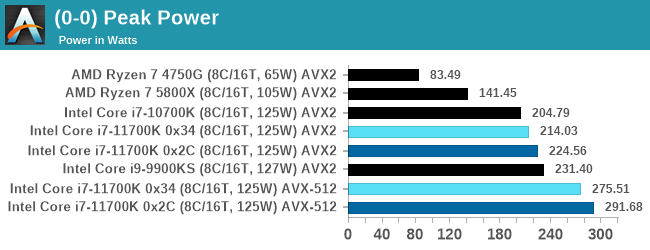



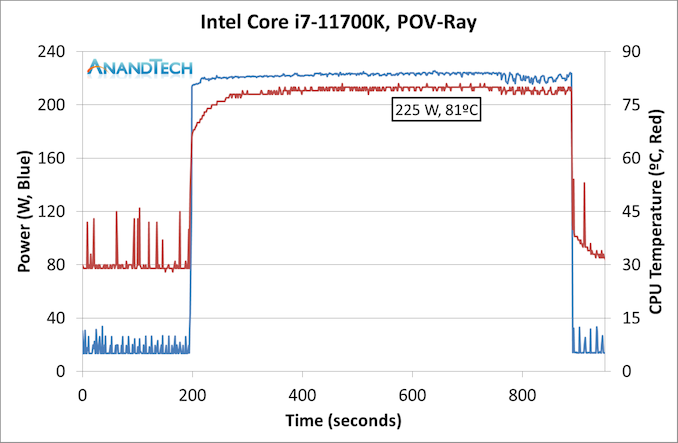
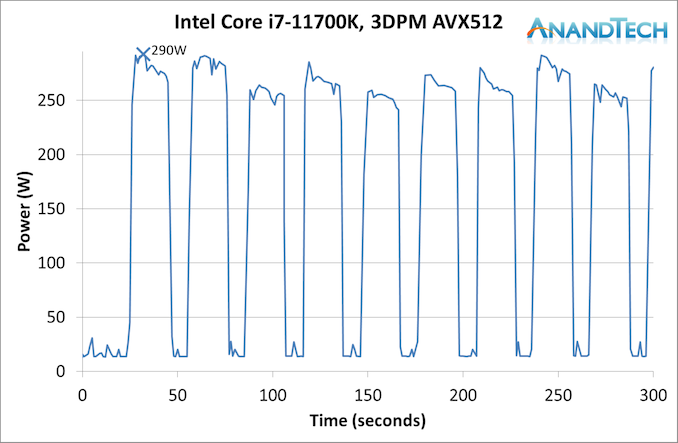
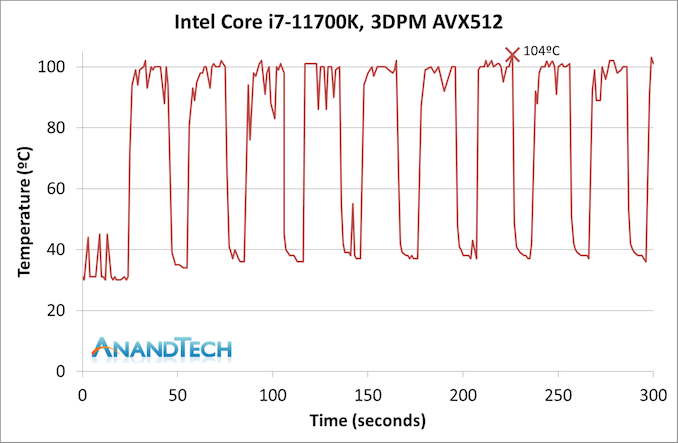


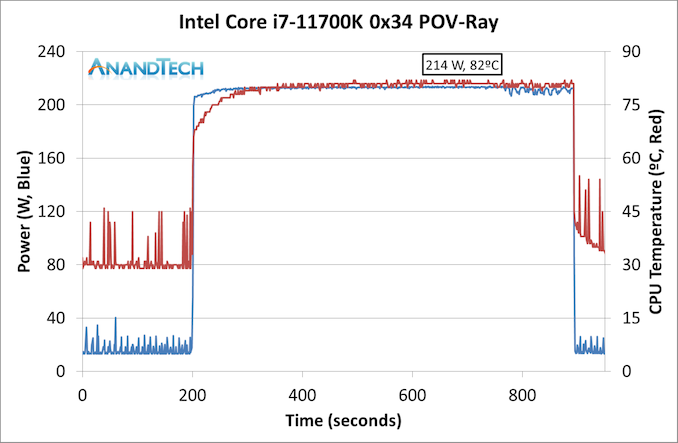








541 Comments
View All Comments
brucethemoose - Monday, March 8, 2021 - link
1: AT benches on Windows, and right now x86 vs ARM is kinda Apples-to-oranges on that platform, especially when one starts mixing in emulation and AVX.Give it time. More comparisons will come. But you'll probably see comparisons on Linux/Mac, and open source software in general, sooner.
2: People uses CPUs for different things. Some of these benches are relevant to those people.
At the same time, my use cases weren't really covered here, so... I get what you're saying.
3. Yeah, it seems rather silly to me, especially when Anand test GPU limited AAA games.
Where you really need a big CPU is in simulation/sandbox games, especially in servers for such things, and sluggish early access stuff. But no one ever benches those :/
Silver5urfer - Monday, March 8, 2021 - link
So with the 19% IPC claim and losing to 9900KS and 10700K what is the point of releasing this chip, from Intel. I never got much from AT benches a lot and preferred the Hardware unboxed, Gamernexus guys and others. But if this is the final performance figures, then this is really a DOA product from Intel. How can they allow this ? I never saw Intel in such a position..maybe X299 got rekted when Zen 2 dropped but this is mainstream segment.Damn it. AMD processors have the idiotic stock related issues, add that WHEA and USB shitstorm. Intel has bullshit performance over past gen except a Gen4 addition and extra lanes from chipset. GPUs are out of damn stock as well.
2020 and 2021 both are completely fucked up for PC HW purchases.
Gigaplex - Monday, March 8, 2021 - link
"I never saw Intel in such a position.."The Pentium 4, in particular the Prescott architecture was a dud back in the early 2000's. That era spawned the antitrust lawsuit against Intel for illegally blocking AMD sales since the Intel products weren't competitive.
dwbogardus - Monday, March 8, 2021 - link
The fact that Intel can even remain in a close second place, using a 14 nm process is impressive. Imagine what they could do with TSMC's 7 nm process! It would almost certainly outperform AMD by a significant margin.Bagheera - Monday, March 8, 2021 - link
Really tired of Intel fanboys saying this.architectures are designed for specific nodes - RKL's problems are exactly due to porting an arch onto a node it wasn't designed for.
the fact is Intel is not a partner for TSMC and their archs are not designed for TSMC processes. if Intel were to outsource CPU production to TSMC, they will either have to make a new arch or make make tweaks to existing ones - a multi-million $ endeavor with risms of issues like your just read with RKL.
Hifihedgehog - Tuesday, March 9, 2021 - link
> a close second place^Here we see in his natural environment your common everyday dude who fails at reading comprehension. I guess you didn't read the part about the serious gaming performance losses and latency regressions gen-over-gen, the 10% performance gap in single-threaded or 10-20%+ performance gaps in multithread, or the inexcusably high peak power draw? Talk about deluded...
RanFodar - Monday, March 8, 2021 - link
Though their efforts may be futile, I am glad Intel attempted to do something out of the ordinary; not a Skylake refresh, but a backport that is found to have worse performance. And yet, it is an attempt for Intel to learn their lessons for generations to come.Hifihedgehog - Tuesday, March 9, 2021 - link
Backporting is not a lesson; it is a last ditch effort or a fallback when all else fails on the manufacturing side. Half full, half empty cup viewing aside, they wasted even more valuable engineering manhours into a failed backport when it should have been invested into developing new architectures. A best use would have been developing the next release. The problem is Intel had to make Rocket Lake good enough in synthetic benchmarks to appease their investors. That, however, still does not address the elephants in the room of 10-20% single threaded performance gaps or—the one that takes the cake—the latency regressions that makes gaming worse, Intel’s historic crown jewel. Much like movies that fail at release and live on box office bombs that their producers later opine should have been cut early on in development, Intel should have cut this idea early on. If you are looking for a lesson that Intel should have learned here, there it is: avoid another Rocket Lake backporting disaster and just warm over your current microarchitecture with one more middling refresh one last time.Hifihedgehog - Tuesday, March 9, 2021 - link
Ian, I just want to say thank you for the incredible review. Just ignore the haters on social media and in the comments who get their panties in a bunch. If the product is garbage, say it like it is, like you did and quite well I might add. You were incredibly diplomatic about it and even openly and honestly showed when and where Intel did win on the rare occasion in the benchmarks. It is so silly how people make these CPU companies (who don't know them from Sam Hill) their religion, as if erecting a Gordon Moore or Lisa Su shrine would avail them anything. Silly geese.misiu_mp - Wednesday, March 10, 2021 - link
Is that the new bulldozer?